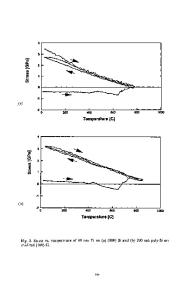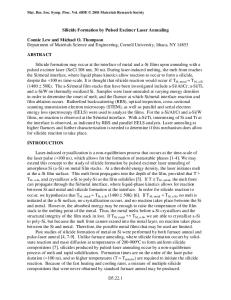Dopant Redistribution during Silicide Formation
- PDF / 866,719 Bytes
- 10 Pages / 417.6 x 639 pts Page_size
- 31 Downloads / 351 Views
I. OHDOMARI, K. KONUMA, M. TAKANO, T. CHIKYOW, H. KAWARADA, J. NAKANISHI, AND T. UENO School of Science and Engineering, Waseda University, 3-4-1, Ohkubo, Shinjuku-ku, Tokyo 160, Japan
ABSTRACT After the review of dopant redistribution phenomena observed during formation of near noble metal silicides, we describe the results of our recent experiments to get a better understanding of a mechanism of the dopant redistribution phenomenon in Si substrates. The key factors to understand the dopant redistribution are dopant segregation at the silicide/ Si interface due to lower solubility limit of dopants in silicides, enhanced diffusion of dopants into the Si substrate at much lower temperatures than the ordinary thermal diffusion, and electrical activation of the redistributed dopants. The results of As and carrier concentration measurements before and after Pd2Si formation to make clear the third factor show that the electrical activity of the redistributed As atoms in Si is strongly dependent on the initial activity before Pd 2 Si formation which is controlled by the temperature for the pre-annealing of As implanted Si. Shrinkage of extrinsic dislocation loops introduced by As implantation and subsequent annealing have been observed after Pd 2 Si formation, which is a good evidence of vacancy generation during Pd 2 Si formation. The role of the vacancies and interstitials on the second factor, the enhanced diffusion, has also been discussed. Finally we list a few issues to be answered in future by more detailed works in order to get a complete understanding of the redistribution phenomenon. INTRODUCTION Silicide/Si contacts have received much attention for application in VLSI technology. The most important reason for using silicides as electrode materials is, as is well known, that they have much lower resistivity than polycrystalline Si. In addition, the silicide/Si interface after interfacial reaction, is formed in a clean Si region away from acontaminated Si surface. The interfacial solid reaction is essential for reproducibility and reliability of contact properties, for which there is growing demand as the number of contacts in VLSI circuits increase. The contact properties such as Schottky barrier height (SBH) and residual contact resistance, however, are determined by a choice of a silicide. For metal/Si Schottky barriers, shallow implantations have been tried successfully for the better control of SBH [1]. For silicide/Si contacts, we can expect a similar effect of ion implantation and the possibility of locating the silicide/Si interface at a desired position of initial implanted impurity distribution by a suitable choice of formation conditions. The results for Pd/As-implanted Si systems, however, was not successful: ohmic characteristics were obtained not only in the shallower region but also for a depth far beyond the initial As distribution. This means that some of the As atoms in the consumed Si region redistribute into the region beneath the silicide/Si interface and become electrically active with con
Data Loading...









